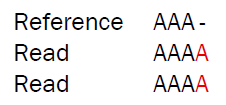Filtering of variants in homopolymeric regions
Different sequencing platforms generate different types of sequencing errors, which can cause incorrectly called variants. The most common source of sequencing errors across platforms is the determination of nucleotides in so-called homopolymeric regions. These are regions that include stretches of the same nucleotide (e.g. AAAAA or TTTTTTTT). As a result of the internal chemistry used on platforms such as 454 and Ion Torrent, the number of identical nucleotides in such regions is often not accurately reported. This causes variant-callers to identify within homopolymer regions, insertions and deletions not actually present in the sample. The Illumina platform has a similar problem in which one nucleotide is surrounded by other nucleotides of the same type (e.g. AAAAGAAAA). Such cases are sometimes misread, with the different base identified as being the same as the surrounding nucleotides. This can lead to incorrect SNV calls. For example, a region of AAAAGAAAA in the sample may appear as AAAAAAAAA in the read. This could lead to a variant allele, A, being called where the G appears in the reference, when in fact the sample itself did contain a G at that position.
The Probabilistic Variant Caller includes an internal filter to recognize and prevent variants being reported in homopolymeric regions.
The 454/Ion Torrent homopolymer filter does not report insertion or deletion variants found at the ends of regions of two or more nucleotides of the same kind (e.g. AA, TT, GGG).
An example is given in figure 31.9:

Figure 31.9: Example of insertions filtered out using the 454/Ion Torrent homopolymer filter.
The red A will not be reported as a variant when the 454/Ion Torrent filter is applied, as it is characteristic of sequencing errors frequently observed on those platforms.
